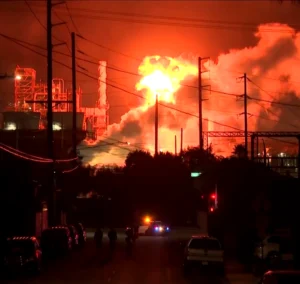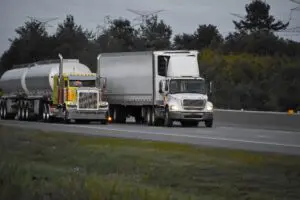In a country where more than 70% of goods are transported by road, truck mechanics have become essential players in the U.S. logistics system. Today’s truck technicians must master technology, precision, and problem-solving—far beyond turning wrenches. In return, the profession offers stability, strong salaries, and high job demand.
While the debate about the value of college degrees continues, thousands of young Americans are choosing an alternative path: becoming certified diesel technicians. This is not a fallback option—it’s a strategic decision backed by clear data. The trucking industry urgently needs skilled workers and is willing to pay well for them.
Modern truck mechanics do far more than fix engines. They are digital code readers, electronic system specialists, data interpreters—and often the first to detect failures that could cost a logistics company millions or compromise safety on the road.
The average annual salary for a diesel technician in the U.S. ranges from $50,000 to $75,000, but can exceed $90,000 with experience and specialized certifications.
Demand is high. Shops, dealerships, private fleets, logistics hubs, and transportation companies are constantly hiring reliable mechanics—especially in states like Texas, California, Georgia, Florida, and Illinois.

What Does a Good Truck Mechanic Need to Know?
Being a professional truck mechanic takes far more than basic tool skills. It requires deep technical knowledge, sharp attention to detail, and problem-solving under pressure. Key competencies include:
Diagnosing and repairing modern diesel engines
Working with air brake systems and ABS
Servicing manual and automatic transmissions
Reading wiring diagrams and using computerized diagnostic tools
Understanding electronic engine management systems, including sensors and ECMs
Repairing hydraulic, suspension, steering, and cooling systems
Following Department of Transportation (DOT) safety and inspection standards
Using tools safely and following workshop and roadside safety protocols
Soft skills matter too: clear communication, organization, punctuality, and a strong commitment to technical and environmental standards.
“Today’s truck technician is half mechanic, half analyst,” say industry experts. “They have to know what the vehicle is telling them—through sensors, diagnostic codes, and real-world symptoms.”
Where Can You Study?
Becoming a diesel technician doesn’t require a four-year degree—but it does require formal training, typically ranging from 6 months to 2 years. Top training options in the U.S. include:
Universal Technical Institute (UTI): Intensive diesel programs at multiple campuses
Lincoln Tech: Hands-on training with strong industry partnerships
Penn Foster: Online courses with diesel engine modules
Community Colleges: Public institutions across the U.S. offering associate degrees in Diesel Technology
Apprenticeship Programs: On-the-job training through shops or fleet employers—often paid
ASE Certifications (Automotive Service Excellence): Optional but highly respected credentials for brakes, electronics, engines, and more
Many schools offer night classes or hybrid formats for working students. Financial aid and scholarships are also available, especially for high school graduates and military veterans.
A Career That Won’t Be Outsourced or Automated
Unlike many jobs threatened by automation or offshoring, heavy-duty mechanics are here to stay. The work is hands-on, practical, and grounded in real-world conditions. Every truck on the road needs expert maintenance—and that can’t be outsourced or handled by AI alone.
As the U.S. economy continues to rely heavily on freight trucking, mechanics remain essential. In that context, diesel technician training is not just a secure career move—it’s a strategic one.
Why AI Won’t Replace Truck Mechanics
Despite rapid advances in artificial intelligence, truck mechanics remain irreplaceable. Here’s why:
Direct manual intervention: Many repairs require physical strength, real-time adaptation, and dexterity with parts in unpredictable conditions.
Diagnosis in complex environments: Trucks operate in extreme weather and wear conditions that aren’t always standard or predictable—human judgment still wins.
Vehicle individuality: Each truck has a unique history, behavior, and wear pattern. AI can assist, but only human experience can give final answers.
Emergency and mobile work: Truck mechanics often work roadside, in distribution yards, or during off-hours. Robots aren’t doing that anytime soon.
Decision-making in real time: Adjusting a clutch, interpreting a strange sound, or deciding if a rig can hit the road involves responsibility and common sense—not just data.
Human trust and communication: Talking to drivers, explaining repairs, giving maintenance tips, and building trust—all remain deeply human aspects of the job.

World Smile Day: benefits of sharing a smile
World Smile Day is celebrated on the first Friday of October, so let’s do an act of kindness and help one person smile. World Smile

Massive fire at Chevron refinery sparks safety concerns and fuel price fears
A massive fire broke out at Chevron’s refinery in El Segundo, the largest oil production facility on the West Coast. On the night of October

MEET operation: 82 commercial vehicles inspected at the Wyoming-Colorado border
The MEET operation, a traffic enforcement operation targeting CMVs, was carried at the Wyoming and Colorado border. A traffic enforcement operation targeting commercial motor carriers,

Road safety reforms: coalition demands for results
The Truck Safety Coalition (TSC) calls for road safety reforms following deadly truck crash report. The Truck Safety Coalition (TSC) is calling for safety reforms

DOT suspends federal funding in New York amid civil rights review
U.S. DOT announces interim final rule banning race- and sex-based contracting requirements in federal grants. The U.S. Department of Transportation (DOT) has issued a statement

U.S. government shutdown begins: how will the transportation industry be affected?
A U.S. government shutdown began a shutdown on October 1, 2025, but the Department of Transportation released its operational plan. The U.S. government shutdown began
